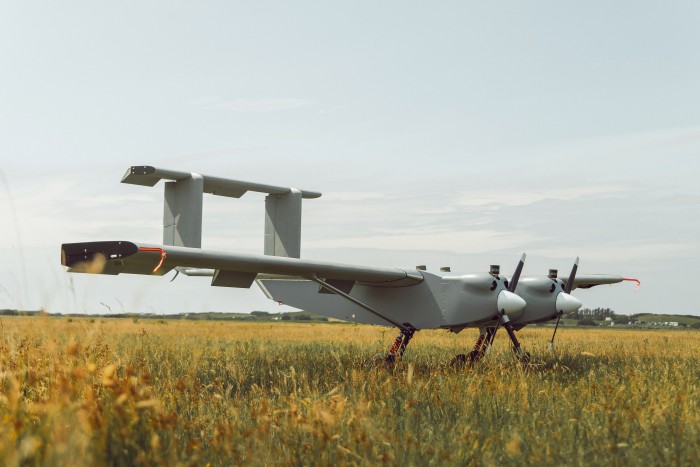Windracers’ long-distance drones ready to deliver aid to conflict zones

Roula Khalaf, Editor of the FT, selects her favourite stories in this weekly newsletter.
In June, the UN’s High Commission for Refugees warned of “difficulties in aid delivery” for people seeking to escape the civil conflict in Sudan. Since then, the situation has worsened: the refugee agency is now talking of an “unimaginable humanitarian crisis” in the east African nation.
Beyond the immediate threat of violence, a key problem is getting help to the 1.2mn people who have fled to neighbouring countries. In South Sudan, for example, the UNHCR has said that aid will need to be airlifted — a process it describes as “both costly and complex”.
But Stephen Wright, co-founder and executive chair of UK drone maker Windracers, says its machines could be a solution in countries affected by conflicts like these. He also thinks they have the potential to transform transportation in other developing nations.
“There are huge challenges to the delivery of humanitarian aid in emergency situations,” Wright says, “ranging from the issues of security to environmental conditions. [The areas] where the aid is required don’t have the transportation infrastructure that we have in western Europe or North America.”
Wright was previously a director at HSBC. He started the bank’s project finance work in southern Africa and arranged the funding for the $370mn Maputo Corridor Toll Road, which connects Pretoria in South Africa to Maputo, the capital of Mozambique.
“From that project, I understood how expensive infrastructure [is]: at that time, it was something like $1mn per km,” he recalls. “That’s really what inspired me, because I could just see that there’s a requirement for a different solution than what has historically been available.”

Wright believes that some countries, reluctant to take on the debt required for such development, will simply “leapfrog” over “classic road infrastructure solutions” and focus on aviation for the transportation of goods.
“Let’s face it, if you started off with a totally clean slate, would you cover the UK with all its roads? You probably wouldn’t have done [it],” says Wright, who set up Windracers in 2017.
The company believes its autonomous drones could be used for multiple purposes, including the delivery of mail, bypassing the need for a road network.
Windracers’ drones can carry a load weighing 100kg as far as 1,000km, but the focus is on “the middle mile, so that’s 50km to 500km,” explains Wright.
As well as mail, the company sees potential roles in sectors including defence, humanitarian aid, firefighting and academic research.
“We’ve developed and tested a drop mechanism [and] that’s going to give us the capability to start doing the delivery of humanitarian aid,” says Wright.
Windracers is talking to the World Food Programme and the International Civil Aviation Organization — a UN agency that helps align air regulations worldwide — about using its drones for humanitarian aid in Somalia and Mozambique, he notes.
The company has already secured £30mn through funding and grants, and will be seeking further growth investment next year. It has 60 full-time employees in the UK and 50 at its offshore manufacturing hub, in India.
So far, the drones have been deployed by organisations including the British Antarctic Survey and the Royal Navy. BAS is using them to carry sensors for collecting scientific data across Antarctica.
The partnership between Windracers and BAS has been funded by technology support agency Innovate UK’s £300mn Future Flight Challenge. It is part of a pilot programme that aims to show how drone technology can be used to gather environmental data.
Tom Jordan, an aerogeophysicist at BAS, says Windracers is “hitting quite a good sweet spot in terms of its payload and range capability”.
BAS can attach “lots of different sensor packages, without worrying too much about weight”, Jordan says — although he notes that smaller uncrewed aerial vehicles “might actually be more appropriate for [other] science targets in [the] future”.
Windracers’ 10-metre fixed-winged aircraft will be deployed in Antarctica between January and March 2024. Masterless, the autopilot system they will use, was developed and patented by Distributed Avionics, which is part of the Windracers group.
“I really want to come out of it knowing that we’ve got a UAV [unmanned aerial vehicle] platform we can use in Antarctica for a range of applications,” says Jordan. But he also hopes that the flights will yield valuable scientific information.
The radar data gathered will feed into models that will help scientists understand the stability of “various parts of the Antarctic ice sheet”, while data from cameras could provide insights into vegetation cover or animal populations.
“Going forward, over future years, if we could do these surveys repeatedly, we can monitor the change, and what the impact of climate change on the ecosystem in Antarctica actually [is],” Jordan says.
Susanne Bieller, general secretary at the International Federation of Robotics, says that drones could be useful in remote locations, but cautions that their viability is dependent on local legislation.
“[This] is what makes the prediction of success of drone companies a bit tricky,” she adds. “There are some [drones] out there that could potentially operate autonomously . . . but in many countries legislation requires a pilot.”
Wright says regional legislation is a further factor behind the company’s interest in developing economies: “They understand this is the future and they’re putting in place the regulations and the laws to allow it to happen.”

Comments